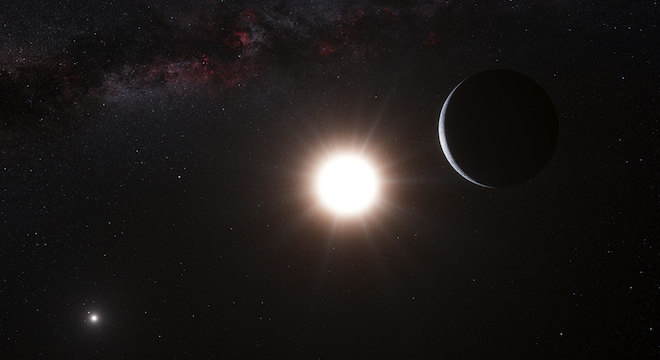The closest planet yet outside of our solar system has been found by European astronomers orbiting Alpha Centauri B, one of the three stars that make up the Alpha Centauri system, which, at 4.3 light years away, is the nearest star system past our Sun.
“This result represents a major step towards the detection of a twin Earth in the immediate vicinity of the Sun,” said Xavier Dumusque, an astronomer at the Universidade do Porto, Portugal, and the lead author of a new paper on the discovery, in a statement on Wednesday. “We live in exciting times!”
“Immediate vicinity” is relative though: It would take a spacecraft like NASA’s unmanned Voyager, which is currently on the edge of the solar system, about 40,000 Earth years to reach Alpha Centauri.
The new planet, designated Alpha Centauri Bb, has a nearly Earth-sized mass (1.13 Earth masses) and is thought to be rocky.
Check out the following ESO video simulation of a rapid journey to the Alpha Centauri system and the newly discovered planet:
It was discovered using a new “intensive observational strategy” pursued over the past four years using the HARPS high-resolution spectrograph instrument on the ground telescope at La Silla Observatory, in Chile. The instrument was pointed at the star Alpha Centauri B three times every night that sky conditions permitted at two-hour intervals. Reseachers found that the star was “wobbling,” moving closer and further away from Earth, a movement that could have only been caused by the existence of a planet.
“The first hint of the planet came out in January this year,” wrote Dumusque in an email to TPM. “From statistical studies, 50 percent of stars have a planet with a mass below Saturn-mass, therefore it was not so surprising to found a planet around this neighbor star. The more exciting was that this planet had an Earth-mass, the smallest mass detected orbiting a solar-type star.”
The new planet orbits Alpha Centauri B, which is a slightly smaller, cooler and more orange version of our Sun. But neighboring star Alpha Centauri A, located 2.2 billion miles away, would still appear in the planet’s sky — making it yet another world similar to the fictional planet Tatooine, Luke Skywalker’s homeworld in “Star Wars.”
Alpha Centauri B’s orbit around its primary star is just 3.8 million miles, a distance closer to its primary star than Mercury is to our Sun. It’s “year” is equivalent to 3.2 Earth days.
As such, the new planet’s superhot surface temperature rules out the possibility that it is habitable.
“This is the first planet with a mass similar to Earth ever found around a star like the Sun,” said Stéphane Udry an astronomer at the University of Switzerland who helped confirm the discovery, in a press release on the website of the European Southern Observatory. “Its orbit is very close to its star and it must be much too hot for life as we know it. But it may well be just one planet in a system of several.”
Indeed, in the paper describing the discovery published in the journal Nature on Wednesday, the researchers note:
“Recent statistical analyses and theoretical models of planetary formation suggest that lowmass rocky planets and especially Earth twins should be common. We are therefore confident that we are on the right path to the discovery of Earths analogues.”
So while we may not be visiting Alpha Centauri or locating any life on the new planet found in the system, there could be other, more promising candidates right around the corner.
Updated to add quote from Dumusque sent to TPM and ESO video simulation of a journey to the planet from Earth.






